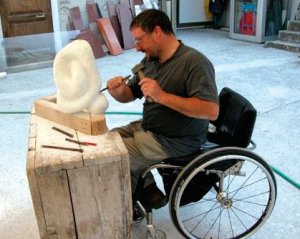In Sync
Jo Verrent explains how Sync is working to change perceptions of disability and leadership.

Back in June, Sync, a new leadership development programme, was launched with a clear but unusual focus – the interplay between disability and leadership. This was unusual because, despite the vast range of leadership programmes, publications and resources available, few have focused on this perspective. Sync now has more than 100 members, all disabled people active in the cultural sector. Different takes on leadership, on disability and on leading as a disabled person abound, making it a rich field for debate and discussion. Sync isn’t pushing a ‘special’ view of leadership: instead we consider if our experiences as disabled people impact upon the way we lead and the way others perceive us leading. The content is mainstream, but the slant is specific.
Sync is open to any disabled person, but access isn’t always equal – to paraphrase Orwell’s ‘Animal Farm’, although all have access, some have more access than others. To date, Sync has primarily been delivered through the internet. Each month, two e-bulletins are sent out: one concentrates on leadership issues and one provides a coaching perspective. More detailed information and further reading is provided on our confidential ‘Basecamp’ web-based tool. Easy-read versions of the bulletins are produced to support those with learning disabilities, and we have organised face-to-face sessions to support deaf leaders and learning disabled leaders. Real time, face-to-face meetings are among the most expensive ways of delivering a national programme, but remain one of the most accessible, provided that the design, delivery and support take inclusion as the starting point. Addressing this, Sync has invited 20 members to meet to explore a range of issues and take part in personalised coaching sessions.
Is there a ‘disability leadership style’? Not exactly, but what is emerging is that for some disabled people, their experiences of exclusion feed into the way they lead. This makes for a more consensual style of leadership – involving people, supporting and mentoring others, listening – all traits that are at odds with the old-fashioned view of a leader. The main theme that reoccurs is the experience of barriers – not the concrete barriers linked to a lack of access (although lack of physical access and communication support is still reported) but the barriers of expectation and assumption. Tony Heaton, Chief Executive of Shape, tells of the time when he was presenting an award and the assembled guests made way so his wheelchair could get to the front. No one had realised that he was going to be giving the award, and so he had to fight through barriers to get onto the stage. Throughout the life of Sync we have heard similar tales, of people having to push past the assumptions of others and to create – in their own heads as much as other people’s – the expectation that they can lead. As one Sync member, Sue Williams, Senior Strategy Officer at Arts Council England, puts it, “Having an impairment from birth you are led to believe that your participation in life and the world is secondary to non-disabled people. You are expected only to aspire to other people’s expectations of you.” One of Sync’s main aims is to challenge this expectation, first among the members of the programme, and then within the wider cultural sector. So let us leave you with a question: how can we help to challenge your expectations of disabled leaders?

Join the Discussion
You must be logged in to post a comment.